Data & Research
This information collection is for activities associated with SNAP demonstration projects and the SNAP State Options Report, respectively.
This memo provides State agencies with guidance on allowable use of advanced automation technologies.
Applications Now Open for States to Streamline Access to Free, Reduced Price School Meals
Did you know there’s a way for children in Medicaid households to be automatically eligible for free and reduced price school meals without their families completing another application? It’s called the Direct Certification with Medicaid Demonstration Project and USDA recently opened applications for more states to participate.
Currently, 38 states participate in the demonstration project, which represents 91% of the nation’s K-12 students. In school year 2019-20, these demonstration projects allowed states to directly certify more than 1.4 million students for free and reduced price meals based on Medicaid data.
New states will have the opportunity to start this project in school years 2024-25, 2025-26, or 2026-27. USDA will consider applications received through Nov. 30, 2025.
Automatic eligibility is a win-win for students, families, and school officials because it provides benefits such as:
- Lower food costs for families,
- Lower school meal debt,
- Higher student participation in school breakfast and lunch programs, and
- Less time and administrative burden for hardworking school nutrition staff.
Arizona, for example, began participating in the Direct Certification with Medicaid Demonstration Project this school year (2023-24) and is experiencing positive results from it. According to Tom Horne, the state’s superintendent of public instruction with the Department of Education, the pilot has already benefited thousands of additional Arizona students who now can receive breakfasts and lunches free of charge each school day, and their families no longer need to fill out an application.
Direct Certification with Medicaid will also give more kids access to USDA’s new Summer Electronic Benefits Transfer program, also known as Summer EBT, which will launch in summer 2024. Households with students who are automatically eligible for free school meals will also be automatically eligible to receive $40 per summer month (per child) in grocery benefits if they live in states, territories, and Tribal Nations that participate in Summer EBT.
Children are also automatically eligible for free and reduced-price school meals – and Summer EBT benefits – if they live in households that participate in other income-based federal assistance programs, such as the Supplemental Nutrition Assistance Program, also known as SNAP.
More information about the Direct Certification for Medicaid Demonstration Project is available on the FNS website.
FNS is conducting additional demonstration projects to expand the evaluation of direct certification with Medicaid for both free and reduced price meal eligibility in NSLP and SBP.
FDPIR Self-Determination Demonstration Project
The 2018 Farm Bill authorized USDA to establish a demonstration project for one or more tribal organizations administering the Food Distribution Program on Indian Reservations (FDPIR) to enter into self-determination contracts as defined in section 4 of the Indian Self-Determination and Education Assistance Act, to purchase USDA Foods for the FDPIR food package for their tribe.
Under normal program operations, all USDA Foods provided in the FDPIR food package are purchased and provided by USDA. Through this demonstration project, participating tribes are able to:
- select one or more foods that they would like to procure for inclusion in the food package,
- identify the food(s) in the food package that they would like to supplant with the tribally procured food(s),
- establish contract(s) with a vendor(s) to procure the selected food(s), and
- distribute the tribally procured food(s) alongside other USDA-provided foods in the FDPIR food packages distributed to their tribal members.
There are a few requirements associated with the tribally procured foods, including that they are domestically sourced and that they are of similar or higher nutritional value as the food(s) being replaced.
The demonstration project:
- supports tribal self-governance by allowing participating tribes to purchase similar foods of their choosing, supporting tribal dietary preferences;
- allows tribes to purchase foods through commercial vendors of their choice;
- supports tribal economies as tribes may choose to contract with local, regional, and/or tribal vendors; and
- provides FNS with an opportunity to see how tribal procurement may work under a food distribution program model across region, program size, and food selection.
The map below highlights tribes currently participating in the demonstration project:

Round 2 Projects
USDA awarded $4.4 million dollars to tribal nations participating in round 2 of the demonstration project. Project implementation began in August 2023 with some contracts expected to last up to three years, through 2026. More information on each tribe's project is outlined below.
- Cherokee Nation
Tribally Procured Foods beef chuck roast, ground beef chubs USDA Supplanted Foods beef chuck roast, ground beef chubs Vendors 1839 Cherokee Meat Company (Native vendor) Distribution Months 36 months 

- Confederated Tribes of the Umatilla Indian Reservation
Tribally Procured Foods ground beef, beef chuck roast, celery, lettuce, cabbage, carrot, squash, cucumber, honey dew melon, peaches, oranges, apples, cherries, apricots, eggs USDA Supplanted Foods ground beef, beef chuck roast, celery, lettuce, cabbage, carrot, squash, cucumber, cantaloupe, peaches, Crenshaw melon, apples, cherries, apricots, eggs Vendors Hines Meat Company, Yakama Nation Farms (Native vendor), Rez Chicks Fresh Eggs Cooperative (Native vendor) Distribution Months 36 months - Gila River Indian Community
Tribally Procured Foods tepary beans USDA Supplanted Foods dry beans Vendors Ramona Farms (Native vendor) Distribution Months 14 months - Quinault Indian Nation
Tribally Procured Foods canned albacore tuna, canned Coho salmon, canned King salmon, King salmon fillet, razor clams, ling cod, rock fish USDA Supplanted Foods chunk light tuna, canned chicken, canned beef, frozen salmon, bison, walleye, whole frozen chicken, catfish Vendors Quinault Pride Seafood (Native vendor) Distribution Months 36 months - Sokaogon Chippewa Community
Tribally Procured Foods wild rice, carrots, cauliflower, pickling and slicing cucumbers, sweet corn, roma and slicing tomatoes, zucchini, bison burger, ground beef, pork chops, chicken breast USDA Supplanted Foods wild rice, carrots, cauliflower, cucumbers, sweet corn, tomatoes, zucchini, bison burger, ground beef, pork chops, chicken breast Vendors Forest County Potawatomi's Bodewewadmi Ktegan Farm (Native vendor), Carson Ackley, Wild Rice Harvester (Native vendor), James Polar, Sr., Wild Rice Harvester (Native vendor) Distribution Months 36 months - Spirit Lake Tribe
Tribally Procured Foods bison USDA Supplanted Foods bison Vendors North American Bison, LLC Distribution Months 36 months Beginning Oct. 2023, Spirit Lake Tribe will be offering a variety of tribally procured bison products to their participants as part of their FDPIR Self-Determination Demonstration Project. The products include: bison dogs, bison ribeye, bison sirloin steak tips, and bison burgers.
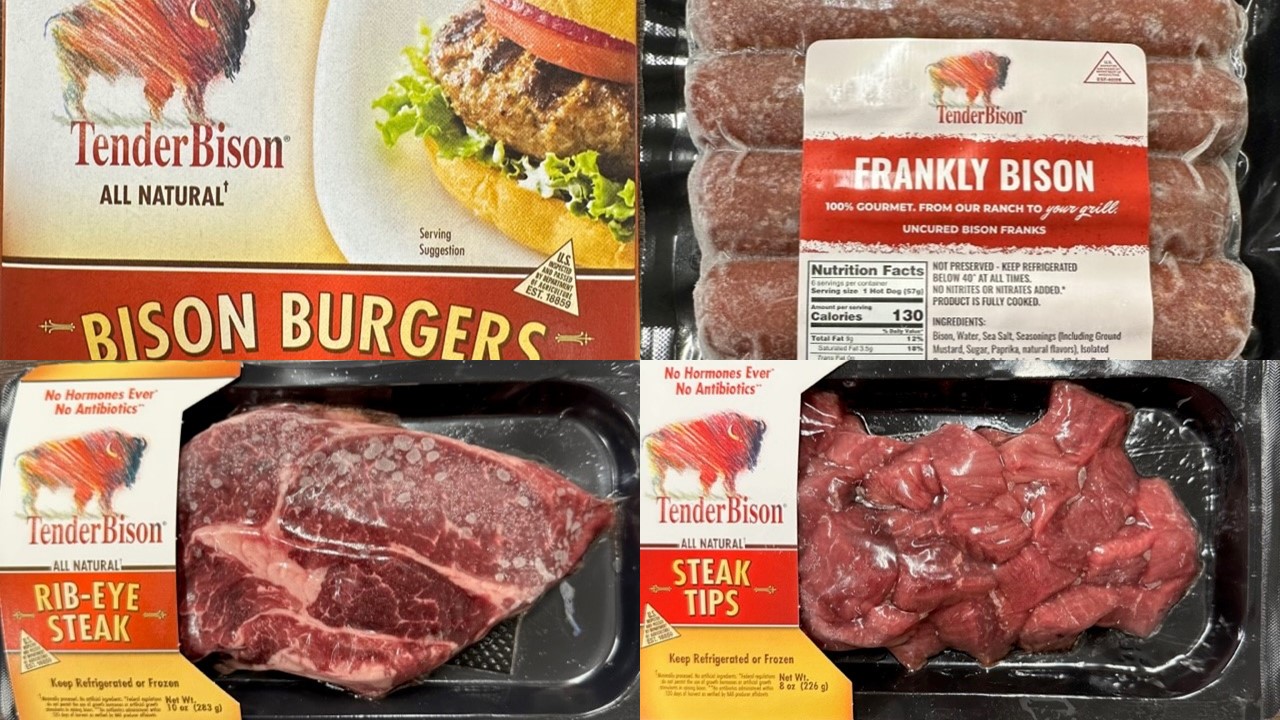
Photo credit: Spirit Lake Tribe - Tohono O'odham Nation
Tribally Procured Foods soft wheat berries (various), hard wheat berries, wheat flour (various), white tepary beans, brown tepary beans, garbanzo beans USDA Supplanted Foods dehydrated potatoes, cherry apple juice, corn flakes cereal, all-purpose flour, egg noodles, canned pinto beans, dry pinto beans, cream of chicken soup Vendors Ramona Farms (Native vendor), San Xavier Cooperative Farm (Native vendor) Distribution Months 36 months - White Mountain Apache Tribe
Tribally Procured Foods barbecue corn, corn, summer squash, patty pan squash, green chilies, blue corn meal, ground beef, tongue, intestines, steak, liver, sweet bread, walnuts, acorns, pine nuts USDA Supplanted Foods canned corn, fresh corn, squash, canned carrots, jalapenos, yellow corn meal, ground beef, bison, chicken, roast beef, canned chicken, canned beef, peanuts, peanut butter, and fruit and nut mix Vendors Ndee Bikiyaa Farm (Native vendor), SPO Land and Cattle Co. Distribution Months 36 months
Round 1 Projects
USDA has awarded $5.7 million dollars to tribal nations participating in round 1 of the demonstration project. Project implementation began in October 2021 with some contracts expected to last up to three years, through 2024. More information on each tribe's project is outlined below.
- Oneida Nation and Menominee Indian Tribe of Wisconsin (joint project)
Tribally Procured Foods ground beef, bison, beef roast, apples, white fish/lake trout, wild rice, walleye USDA Supplanted Foods ground beef, bison, beef roast, apples, catfish/salmon, wild rice, walleye Vendors Oneida Nation Farm, Oneida Nation Apple Orchard, Red Cliff Fish Company, and Spirit Lake Native Farms Distribution Months 6 - 24 months A video showcasing the Oneida Nation - Menominee Indian Tribe of Wisconsin, self-determination demonstration project, and the many benefits the project is bringing to tribal members. Video production credit: The Self-Governance Communication & Education Tribal Consortium (SGCETC).

Wild rice from Spirit Lake Native Farms. The Oneida Nation and Menominee Indian Tribe of Wisconsin are partnering on a joint self-determination demonstration project that will provide tribally procured ground beef, bison, beef roast, white fish, lake trout, apples, and wild rice to their FDPIR participants.

- Little Traverse Bay Bands of Odawa Indians (LTBB)
Tribally Procured Foods all fresh produce, walleye USDA Supplanted Foods all fresh produce, walleye Vendors Red Lake Nation Fishery Distribution Months 24 months Jake Robinson (right), General Manager of Red Lake Nation Fishery, delivers walleye fillets to Joe Van Alstine (left), FDPIR Program Director for the Little Traverse Bay Bands of Odawa Indians. Red Lake Nation Fishery is located in Redby, Minnesota, and is owned and operated by Red Lake Nation.

Photo credit: Jo Van Alstine. - Red Cliff Band of Lake Superior Chippewa
Tribally Procured Foods frozen white fish, carrots, potatoes of various colors, cucumbers, romaine/butterhead/green leaf lettuce, frozen squash, apples, fresh and frozen blueberries, wild rice, tomatoes, onions, summer squash, radishes, cherry tomatoes, winter squash, salad mix, smoked fish USDA Supplanted Foods salmon, carrots, red potatoes, cucumbers, romaine lettuce, canned vegetables, apples, frozen blueberries, wild rice, tomatoes, onions, summer squash, radishes, cherry tomatoes, winter squash, canned fish Vendors Dynamite Hill Farms, Highland Hill Farms, Red Cliff Fish Company, and Mino Bimaadiziiwin Tribal Farm Distribution Months 31 months Program Contact Vincent "Butch" Bresette
Butch.bresette@redcliff-nsn.gov
(715) 779-3740The Mino Bimaadiziiwin Farm, which is owned and operated by The Red Cliff Band of Lake Superior Chippewa, provides fresh produce to FDPIR participants through the demonstration project. Produce items provided by the farm for the project include everything from carrots and squash to lettuce and salad mix.
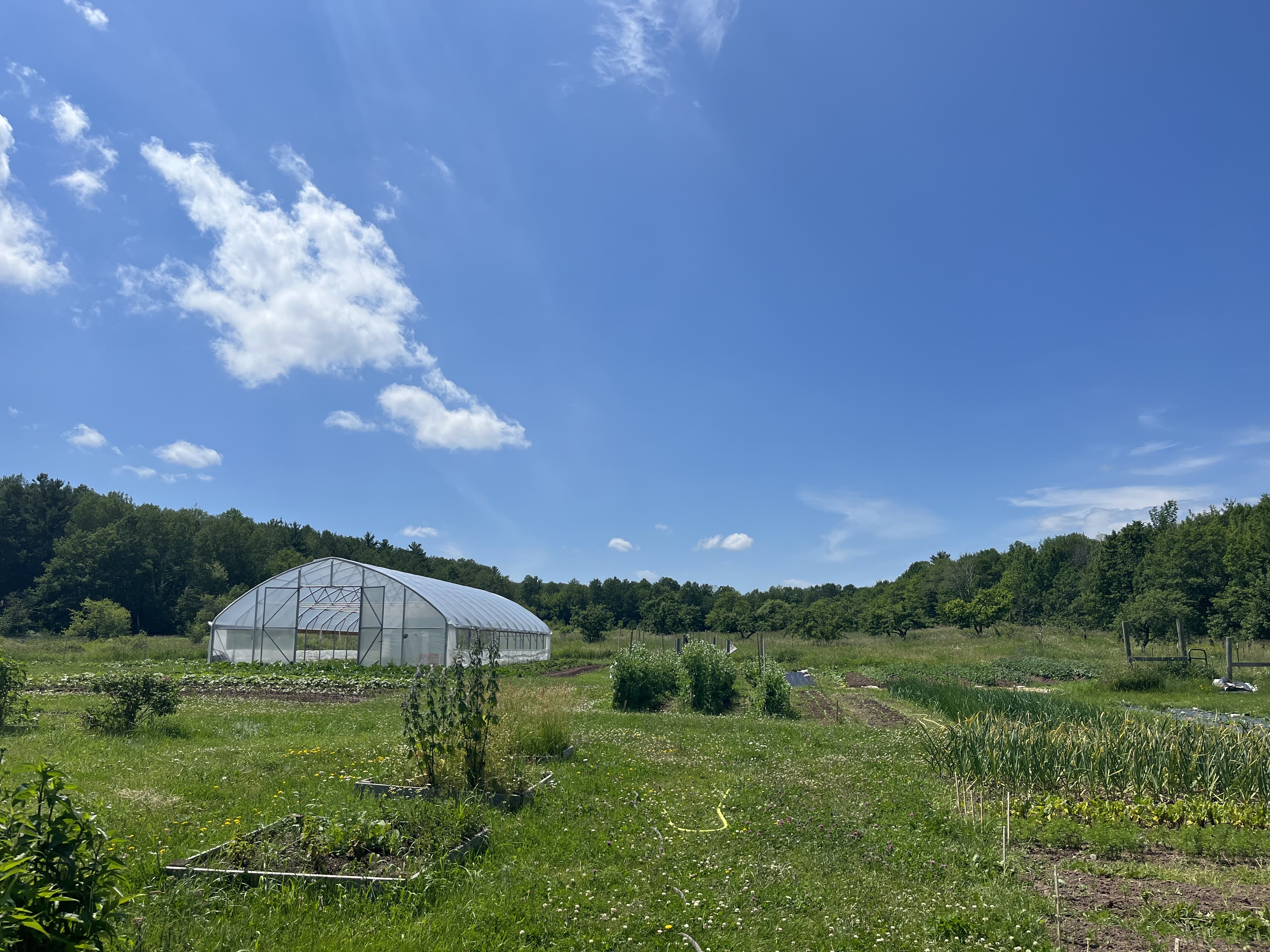
Photo credit: Mino Bimaadiziiwin Tribal Farm. The Red Cliff Fish Company is located within the Red Cliff Reservation, which spans 22 miles of Lake Superior shoreline in northern Wisconsin. Through the FDPIR self-determination demonstration project, Red Cliff Fish Company will provide fish products to FDPIR participants in The Red Cliff Band of Lake Superior Chippewa, the Oneida Nation, and the Menominee Indian Tribe of Wisconsin.
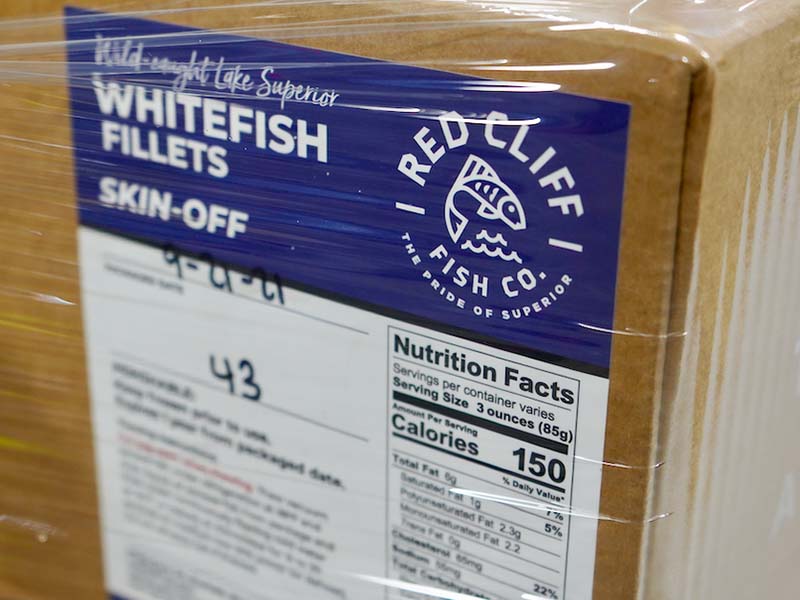
Photo credit: Daniel Cornelius. Check out the project photo gallery.
- Chickasaw Nation
Tribally Procured Foods ground beef, roast beef, dry hominy, stew meat, pecans USDA Supplanted Foods ground beef, roast beef, wild rice, canned beef, peanuts Vendors Rolland Ranch Beef, Guderian Foods, and Bryant Pecan Company Distribution Months 24 - 33 months Ground beef from Rolland Ranch Beef, LLC. The Chickasaw Nation is utilizing FDPIR self-determination contract funding to purchase both ground beef and roast beef from Rolland Ranch Beef, LLC., a tribally-owned and family-operated ranch in Checotah, Oklahoma.
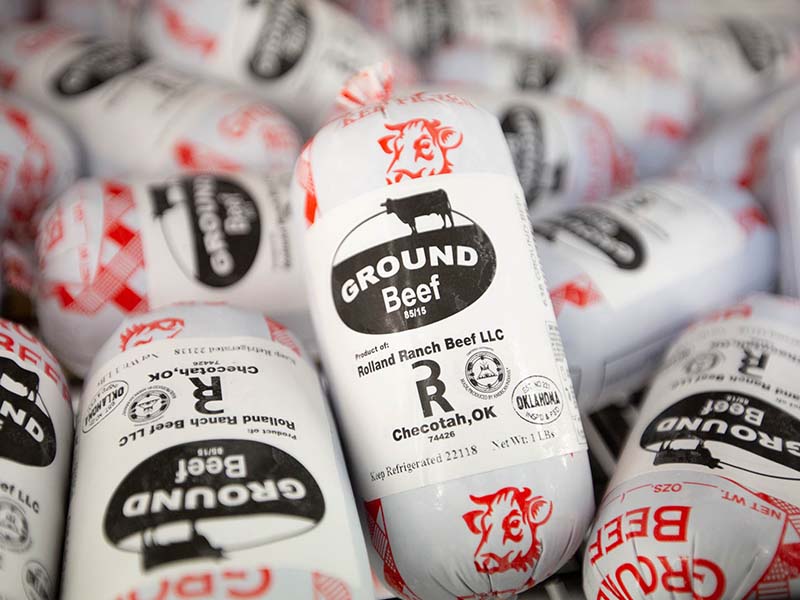
Photo credit: Chickasaw Nation. Beef products from a local tribal producer at a Chickasaw Nation food distribution warehouse. Through the demonstration project, Chickasaw Nation is purchasing a variety of tribally-produced foods for the FDPIR food packages distributed to their tribal members. These products include ground beef, roast beef, dry hominy, stew meat, and pecans.
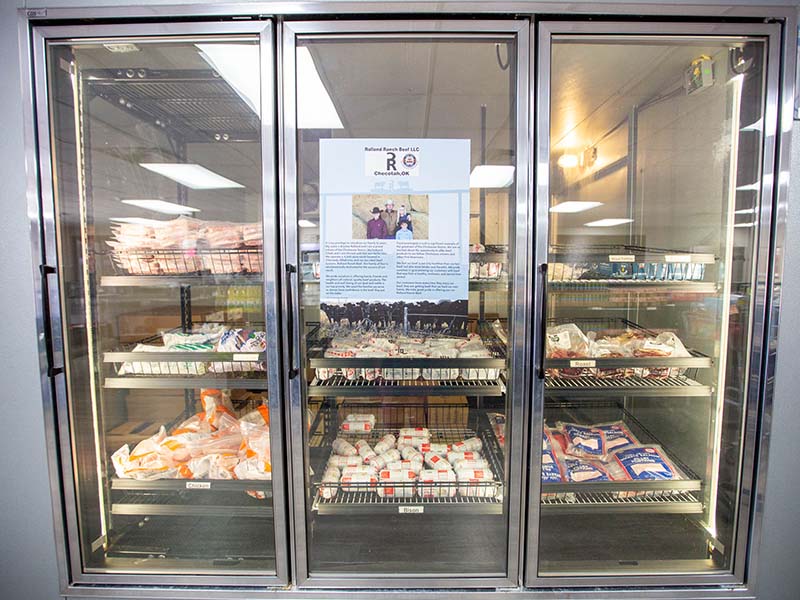
Photo credit: Chickasaw Nation. - Alaska Native Tribal Health Consortium (ANTHC)
Tribally Procured Foods Alaskan halibut, cod, Alaska grown potato USDA Supplanted Foods catfish, walleye, russet potato Vendors Kodiak Island WildSource and Knik Tribe Distribution Months 14 - 28 months Project Contact Dana Diehl
ANTHC Director, Wellness and Prevention
info.fdpir@anthc.org
(907) 729-2440The Alaska Native Health Consortium, known as ANTHC, operates a FDPIR self-determination demonstration project that provides foods to 18 tribes across Alaska. Learn more about the ANTHC project in this video.
Healthy potato plants growing at the Knik Tribe farm near Palmer, Alaska. Beginning in fall/winter 2022, the Alaska Native Tribal Health Consortium will purchase potatoes from the farm with FDPIR self-determination contract funds.

Gregory Nothstine (center), FDPIR Program Director for the Alaska Native Tribal Health Consortium (ANTHC), and Mike Reusser (left) and Jim Baldwin (right) of the Food Bank of Alaska (FBA), receive a first shipment of Alaskan halibut at the FBA warehouse in Anchorage, Alaska. ANTHC purchases the fish with self-determination contract funds and then works with FBA to ship the product (along with other FDPIR foods) to 21 tribal villages throughout the state.
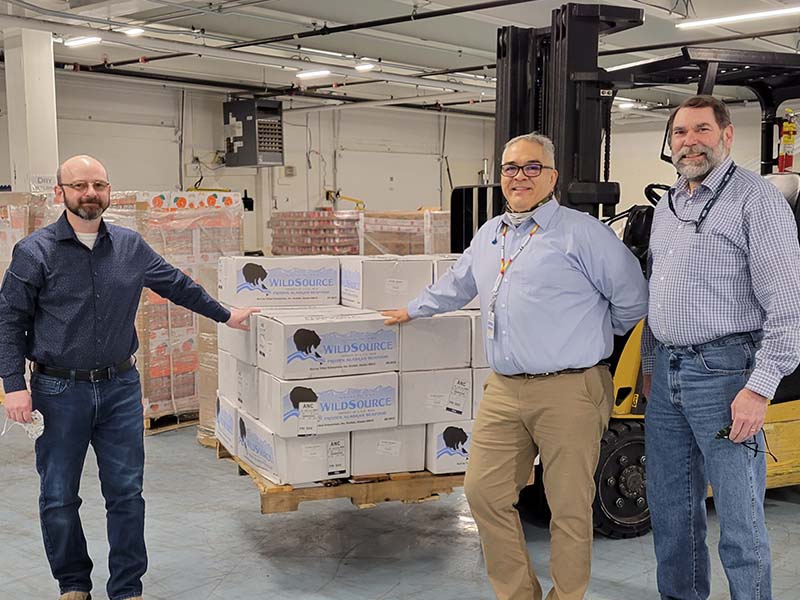
Photo credit: Food Bank of Alaska. Barbara Lopez (FNS Senior Technical Advisor for Supplemental Nutrition and Safety Programs), Gregory Nothstine (FDPIR Program Director for the Alaska Native Tribal Health Consortium (ANTHC)), and Dana Diehl (Director of the Wellness and Prevention Department at ANTHC), in front of the Kodiak Harbor in Kodiak, Alaska. Fresh Alaskan cod and halibut for the demonstration project are fished out of the harbor and processed by Kodiak Island Wildsource, a business owned and operated by the Sun'aq Tribe of Kodiak, before being shipped to FDPIR participants across Alaska.
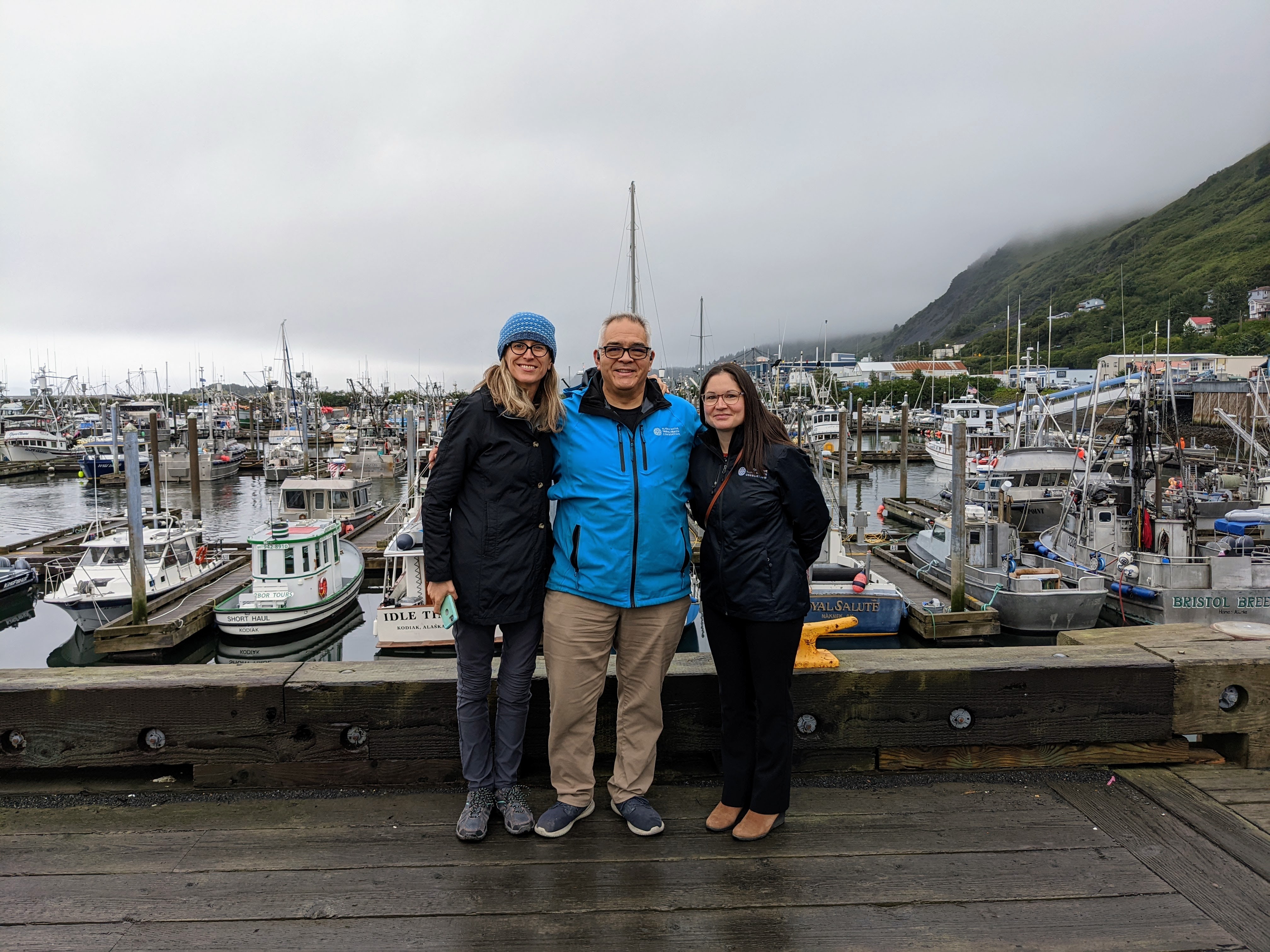
- Lummi Nation
Tribally Procured Foods salmon, halibut, prawns/shrimp, crab USDA Supplanted Foods catfish, walleye Vendors Nexwelhqeyem Seafood, LLC and Finkbonner Shellfish Distribution Months six months or more Lummi Nation Commodity Foods staff proudly display frozen sockeye salmon fillets purchased with FDPIR self-determination contract funds. Lummi Nation manages several treaty-reserved fisheries off the Washington coast and will be providing a variety of local seafood items to FDPIR participants through the demonstration project.
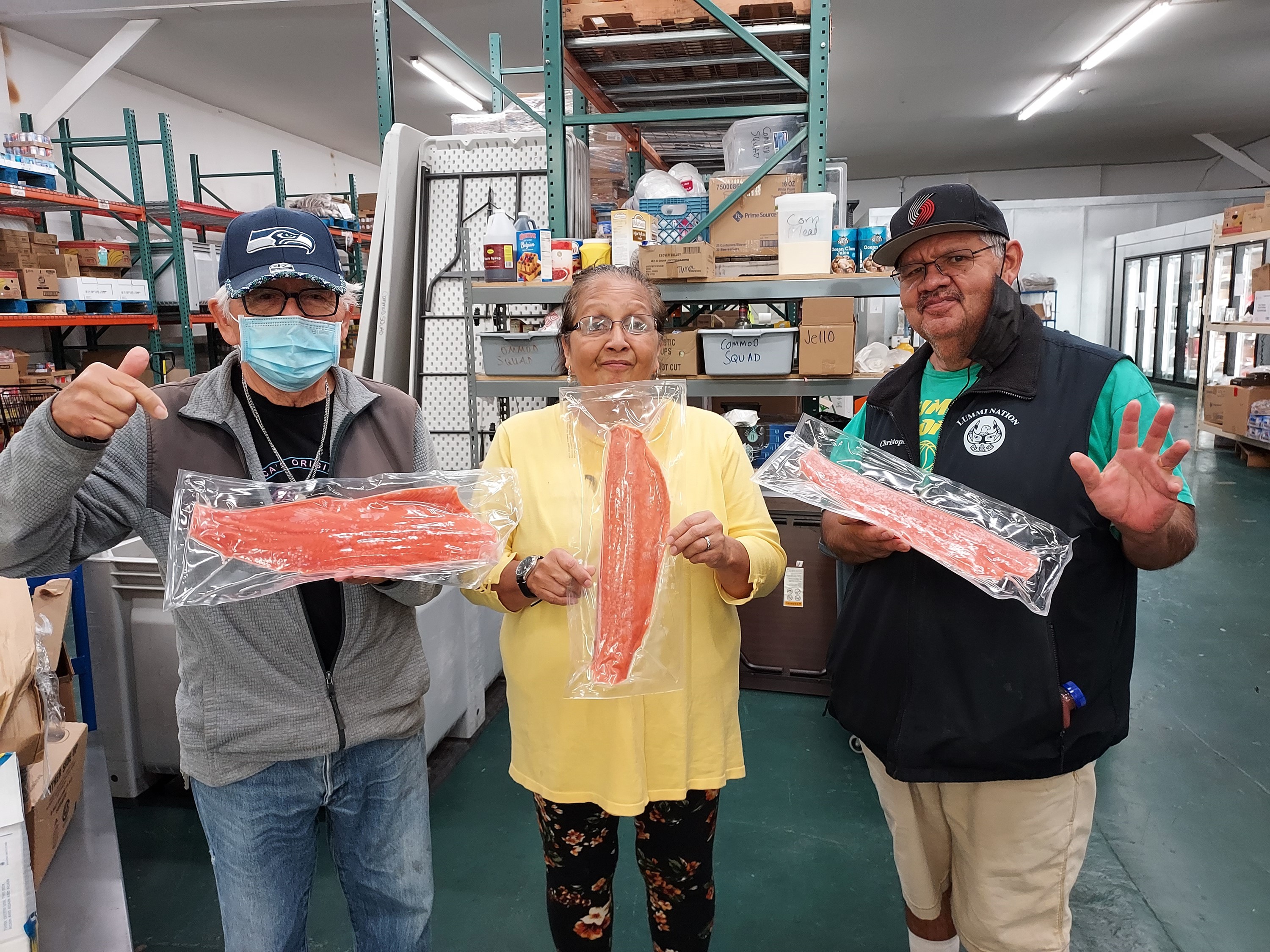
Photo credit: Lummi Nation Commodity Foods. Check out the project photo gallery!
- Mississippi Band of Choctaw Indians (MBCI)
Tribally Procured Foods turnip greens, collard greens, yellow squash, red/green tomatoes, tomato berries, bell peppers, hot/sweet peppers, cucumbers USDA Supplanted Foods romaine lettuce, summer squash, tomatoes, cherry tomatoes, green pepper, cucumbers Vendors Choctaw Fresh Produce Distribution Months 36 months An employee of Choctaw Fresh shows off some fresh collard greens that will be put into FDPIR food packages for eligible tribal members. The Mississippi Band of Choctaw Indians is purchasing a variety of fresh vegetables from the Choctaw Fresh Farm, an organic produce farm located on the Mississippi Band of Choctaw Indians Reservation.
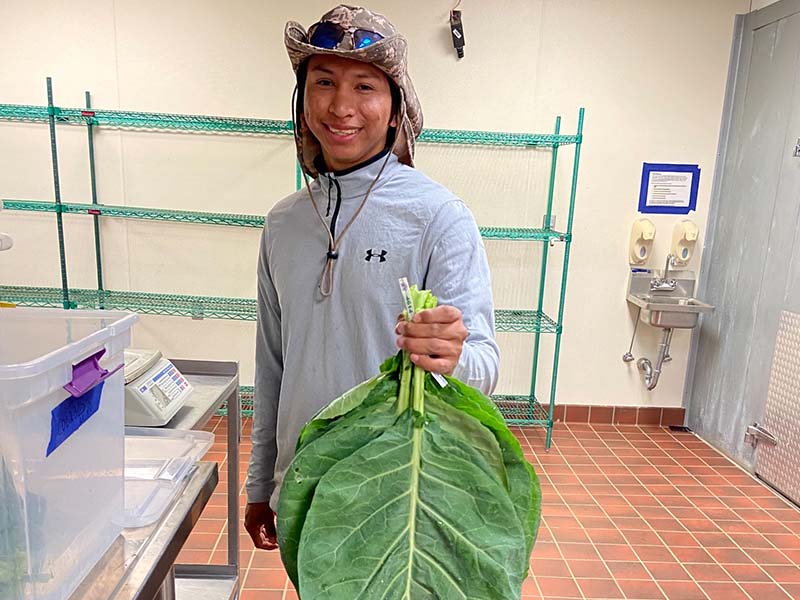
Photo Credit: Choctaw Fresh Farm. Collard green seedlings waiting to be planted in a high tunnel. The Mississippi Band of Choctaw Indians is purchasing turnip greens, collard greens, yellow squash, tomatoes, tomato berries, bell peppers, cucumbers, and a variety of hot and sweet peppers, for FDPIR participants through the FDPIR self-determination demonstration project.
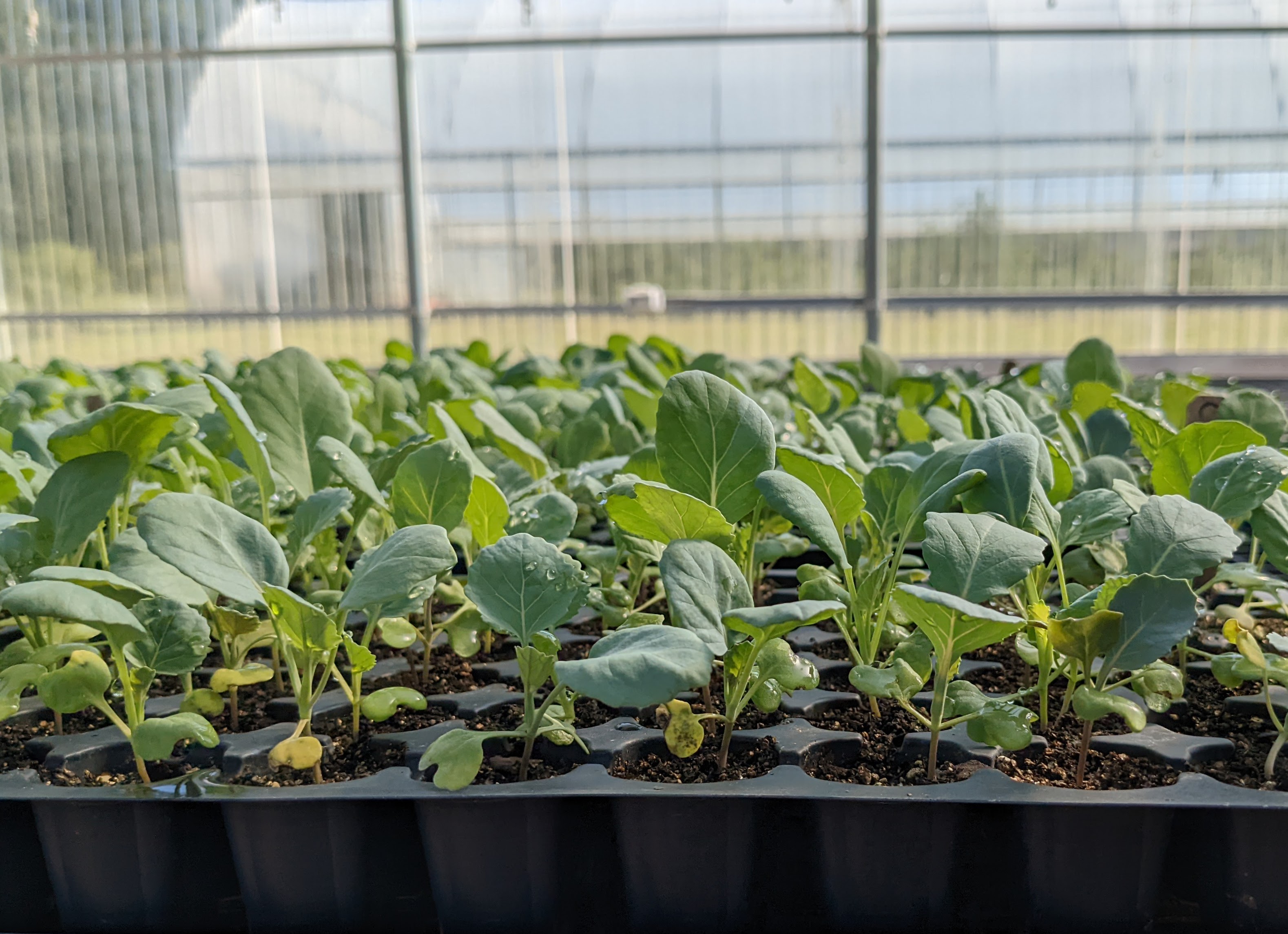
Photo credit: Choctaw Fresh Farm.
Demonstration Project Resources
- Federal Register Documents
- Resources (webinars/FAQs)
- USDA Communications (press releases/blogs)
- FDPIR Sharing Gallery
- USDA Indigenous Food Sovereignty Initiative
The 2018 Farm Bill authorized USDA to establish a demonstration project for one or more tribal organizations administering FDPIR to enter into self-determination contracts to purchase USDA Foods for the FDPIR food package for their tribe.
Here are some resources to find out more about SNAP ABAWDs and related information.
The CEP resource center provides extensive resources for parents, teachers, and school officials at the local, state and Federal level to better understand CEP and its positive benefits, along with useful tools to help facilitate successful implementation of the provision in your school!
ABAWDs can receive SNAP for only 3 months in a 3-year period if they do not meet certain work requirements. This page includes information on waiver status for states by quarter.
ABAWDs can receive SNAP for only 3 months in a 3-year period if they do not meet certain work requirements. This page includes information on waiver status for FY 2020-24 by state.
SNAP Eligibility
To get SNAP benefits, you must apply in the state in which you currently live and you must meet certain requirements, including resource and income limits, which are described on this page. SNAP income and resource limits are updated annually.
The information on this page is for Oct. 1, 2023, through Sept. 30, 2024.
There are special SNAP rules for households with elderly or disabled members.
Frequently Asked Questions
- Am I eligible for SNAP?
Your household must meet certain requirements to be eligible for SNAP and receive benefits. If your state agency determines that you are eligible to receive SNAP benefits, you will receive benefits back to the date you submitted your application.
- How do I apply for SNAP?
You must apply for SNAP in the state where you currently live. Because each state has a different application form and process, a member of your household must contact your state agency directly to apply.
You can contact your state agency by visiting your local SNAP office, visiting your state agency’s website, or calling your state’s toll-free SNAP Information hotline. Some states have online applications that can be completed from the state agency website.
- Where can I get my state information?
If you are unable to go to or call your local SNAP office or do not have access to the internet, you may have another person act as an authorized representative by applying and being interviewed on your behalf. You must designate the authorized representative in writing.
Note: Please contact your SNAP state agency directly to apply and to request information about the status of your application. FNS does not process applications or have access to case information.
- What happens when I apply for SNAP?
In most cases, once you submit your application, your state agency or local SNAP office will process it and send you a notice telling you whether or not you are eligible for benefits within 30 days.
During the 30 days, you will need to complete an eligibility interview and give proof (verification) of the information you provided. The interview is typically completed over the telephone or in-person. If you are found eligible, you will receive benefits based on the date you submitted your application.
You may be eligible to receive SNAP benefits within 7 days of your application date if you meet additional requirements. For example, if your household has less than $100 in liquid resources and $150 in monthly gross income, or if your household’s combined monthly gross income and liquid resources are less than what you pay each month for rent or mortgage and utilities expenses. Contact your state agency for additional details.
- How do I receive SNAP benefits?
If you are found eligible, you will receive SNAP benefits on an Electronic Benefit Transfer (EBT) card, which works like a debit card. Benefits are automatically loaded into your account each month. You can use your EBT card to buy groceries at authorized food stores and retailers.
- When Are SNAP Benefits Available?
(A benefit issuance schedule can be found for each state.) - What Can SNAP Buy?
- What is Electronic Benefits Transfer (EBT)?
- Where Can I Use SNAP?
- When Are SNAP Benefits Available?
- How long will I receive SNAP?
If you are found eligible, you will receive a notice that tells you how long you will receive SNAP benefits for; this is called your certification period. Before your certification period ends, you will receive another notice that says you must recertify to continue receiving benefits. Your local SNAP office will provide you with information about how to recertify.
- Who is in a SNAP household?
Everyone who lives together and purchases and prepares meals together is grouped together as one SNAP household.
Some people who live together, such as spouses and most children under age 22, are included in the same SNAP household, even if they purchase and prepare meals separately.
If a person is 60 years of age or older and unable to purchase and prepare meals separately because of a permanent disability, the person and the person's spouse may be a separate SNAP household if the others they live with do not have very much income (no more than 165 percent of the poverty level).
Normally you are not eligible for SNAP benefits if an institution gives you most of your meals. There are exceptions for elderly persons and disabled persons.
- What resources can I have and still get SNAP benefits?
Currently, households may have $2,750 in countable resources (such as cash or money in a bank account) or $4,250 in countable resources if at least one member of the household is age 60 or older, or is disabled. These amounts are updated annually.
However, certain resources are NOT counted when determining eligibility for SNAP:
- A home and lot;
- Resources of people who receive Supplemental Security Income (SSI);
- Resources of people who receive Temporary Assistance for Needy Families (TANF; also known as welfare); and
- Most retirement and pension plans (withdrawals from these accounts may count as either income or resources depending on how often they occur).
Depending on which state you live in, you may be able to have more resources than the above limits and still be eligible for SNAP. Most state agencies have adopted broad-based categorical eligibility (BBCE), which allows state agencies to align income and resource limits with their TANF-funded programs. Under BBCE, households are categorically eligible for SNAP if they are eligible to receive a TANF or maintenance of effort (MOE) state-funded non-cash benefit. Even if you meet the BBCE income and resource limit in your state, you will still need to meet non-financial eligibility rules and have an income low enough to receive SNAP benefits.
- Do vehicles count as resources?
Vehicles count as a resource for SNAP purposes. States determine how vehicles may count toward household resources.
Licensed vehicles are NOT counted if they are:
- Used for income-producing purposes (e.g., taxi, truck or delivery vehicle);
- Annually producing income consistent with their fair market value;
- Needed for long distance travel for work (other than daily commute);
- Used as the home;
- Needed to transport a physically disabled household member;
- Needed to carry most of the household's fuel or water; or
- If the sale of the vehicle would result in less than $1,500.
For non-excluded licensed vehicles, the fair market value over $4,650 counts as a resource.
Licensed vehicles are also subject to an equity test, which is the fair market value less any amount owed on the vehicle. The following vehicles are excluded from the equity test:
- One vehicle per adult household member; and
- Any other vehicle used by a household member under 18 to drive to work, school, job training, or to look for work.
For vehicles with both a fair market value over $4,650 and an equity value, the greater of the two amounts is counted as a resource.
Additionally, the equity value of unlicensed vehicles generally counts as a resource, with some exceptions.
- What are the SNAP income limits?
In most cases, your household must meet both the gross and net income limits described below or you are not eligible for SNAP and cannot receive benefits.
Gross income means a household's total, non-excluded income, before any deductions have been made.
Net income means gross income minus allowable deductions.
A household with an elderly or disabled person only has to meet the net income limit, as described on the elderly and disabled page.
If all members of your household are receiving Temporary Assistance for Needy Families (TANF), Supplemental Security Income (SSI), or in some places other general assistance, your household may be deemed “categorically eligible” for SNAP because you have already been determined eligible for another means-tested program.
The information provided in the table below applies to households in the 48 contiguous states, the District of Columbia, Guam, and U.S. Virgin Islands that apply for SNAP between Oct. 1, 2023, through Sept. 30, 2024.
Table 1: SNAP Income Eligibility Limits - Oct. 1, 2023, through Sept. 30, 2024
Household Size Gross monthly income
(130 percent of poverty)Net monthly income
(100 percent of poverty)1 $1,580 $1,215 2 $2,137 $1,644 3 $2,694 $2,072 4 $3,250 $2,500 5 $3,807 $2,929 6 $4,364 $3,357 7 $4,921 $3,785 8 $5,478 $4,214 Each additional member +$557 +$429 * SNAP gross and net income limits are higher in Alaska and Hawaii.
- What deductions are allowed in SNAP?
The following deductions are allowed for SNAP:
- A 20-percent deduction from earned income.
- A standard deduction of $198 for household sizes of 1 to 3 people (higher for some larger households and different for households in Alaska, Hawaii, the U.S. Virgin Islands, and Guam).
- A dependent care deduction when needed for work, training, or education.
- Medical expenses for elderly or disabled members that are more than $35 for the month if they are not paid by insurance or someone else. This is described on the elderly and disabled page.
- In some states, legally owed child support payments.
- A standard shelter deduction for homeless households of $179.66.
- Excess shelter costs as described below.
SNAP Excess Shelter Costs Deduction
The excess shelter deduction is for shelter costs that are more than half of the household's income after other deductions.
Allowable shelter costs include:
- Fuel to heat and cook with.
- Electricity.
- Water.
- The basic fee for one telephone.
- Rent or mortgage payments and interest.
- Taxes on the home.
Some states allow a set amount for utility costs instead of actual costs.
The amount of the shelter deduction is capped at (or limited to) $672 unless one person in the household is elderly or disabled. The limit is higher in Alaska, Hawaii, and Guam. For a household with an elderly or disabled member all shelter costs over half of the household's income may be deducted.
Table 2: How to Calculate SNAP Gross Income
Gross Income Calculation Example Determine household size . . . 4 people with no elderly or disabled members. Add gross monthly income . . . $1,500 earned income + $550 social security = $2,050 gross income. If gross monthly income is less than the limit for household size, determine net income. $2,050 is less than the $3,250 allowed for a 4-person household, so determine net income. Table 3: How to Calculate SNAP Net Income
Net Income Calculation Example for a 4-person household Subtract 20% earned income deduction... $2,050 gross income
$1,500 earned income x 20% = $300.
$2,050 - $300 = $1,750Subtract standard deduction... $1,750 - $208 standard deduction for a 4-person household = $1,542 Subtract dependent care deduction... $1,542 - $362 dependent care = $1,180 Subtract child support deduction... $0 Subtract medical costs over $35 for elderly and disabled... $0 Excess shelter deduction... See below Determine half of adjusted income... $1,180 adjusted income ÷ 2 = $590 Determine if shelter costs are more than half of adjusted income... $700 total shelter - $590 (half of income) = $110 excess shelter cost Subtract excess amount, but not more than the limit, from adjusted income... $1,180 - $110 = $1,070 net monthly income Apply the net income test... Since $1,070 is less than the $2,500 allowed for a 4-person household, this household has met the income test. - How much could I receive in SNAP benefits?
The total amount of SNAP benefits your household gets each month is called an allotment.
Because SNAP households are expected to spend about 30 percent of their own resources on food, your allotment is calculated by multiplying your household’s net monthly income by 0.3, and subtracting the result from the maximum monthly allotment for your household size.
Table 4: SNAP Maximum Monthly Allotment Based on Household Size
People in Household Maximum Monthly Allotment 1 $291 2 $535 3 $766 4 $973 5 $1,155 6 $1,386 7 $1,532 8 $1,751 Each additional person +$219 Note: The allotments described here are for households in the 48 contiguous states and the District of Columbia. The allotments are different in Alaska, Hawaii, Guam, and the U.S. Virgin Islands.
Table 5: Example of SNAP Benefit Calculation
Benefit Computation Example Multiply net income by 30%... (round up) $1,070 net monthly income from above calculation x 0.3 = $321 Subtract 30% of net income from the maximum allotment for the household size... $973 maximum allotment for 4-person household - $321 (30% of net income) - $652, SNAP Allotment for a full month - What are the SNAP work requirements?
In general, people must meet work requirements to be eligible for SNAP. These work requirements include:
- Registering for work;
- Not voluntarily quitting a job or reducing hours;
- Taking a job if offered; and
- Participating in employment and training programs, if assigned by the state.
Failure to comply with these requirements can result in disqualification from the program.
In addition, able bodied adults without dependents are required to work or participate in a work program for at least 20 hours per week in order to receive SNAP benefits for more than 3 months in a 36-month period.
Some special groups may not be subject to these requirements including:
- Children;
- Seniors;
- Veterans;
- Individuals experiencing homelessness;
- Individuals age 24 or younger and in foster care on their 18th birthday;
- Pregnant women; and
- People who are exempt for physical or mental health reasons.
- Are students eligible for SNAP?
Generally, students ages 18 through 49 who are enrolled in college at least half time are not eligible for SNAP unless they meet certain specific exemptions.
- Are non-citizens eligible for SNAP?
SNAP eligibility has never been extended to undocumented non-citizens. Specific requirements for non-citizens who may be eligible have changed substantially over the years and become more complicated in certain areas. The Food and Nutrition Act of 2008 limits eligibility for SNAP benefits to U.S. citizens and certain lawfully present non-citizens.
Generally, to qualify for SNAP, non-citizens must meet one of the following criteria:
- Have lived in the United States for at least 5 years.
- Be receiving disability-related assistance or benefits.
- Be children under 18.
Additionally, these individuals must also satisfy other SNAP eligibility requirements such as income and resource limits in order to qualify for benefits.
If certain members of a household are ineligible for SNAP, state agencies must still determine eligibility for SNAP for any remaining household members who are seeking assistance.
For additional information see: SNAP Policy on Non-Citizen Eligibility and SNAP Guidance on Non-Citizen Eligibility.
- What if I disagree with a decision made on my SNAP case?
If you disagree with a decision in your case, you may request a fair hearing with an official who is required by law to review the facts of your case in a fair and objective manner.
You must request a fair hearing within 90 days of the day your local SNAP office made the decision in your case that you disagree with.
You can request a fair hearing over the phone, in writing, or in person at the local SNAP office.
Although a fair hearing cannot change the laws or regulations governing SNAP, it can ensure that decisions on your case have been made correctly.
- Nondiscrimination in SNAP
In accordance with Federal civil rights law and U.S. Department of Agriculture (USDA) civil rights regulations and policies, the USDA, its Agencies, offices, and employees, and institutions participating in or administering USDA programs are prohibited from discriminating based on race, color, national origin, religion, sex, gender identity (including gender expression), sexual orientation, disability, age, marital status, family/parental status, income derived from a public assistance program, political beliefs, or reprisal or retaliation for prior civil rights activity, in any program or activity conducted or funded by USDA (not all bases apply to all programs). Remedies and complaint filing deadlines vary by program or incident.
Persons with disabilities who require alternative means of communication for program information (e.g., Braille, large print, audiotape, American Sign Language, etc.) should contact the responsible Agency or USDA's TARGET Center at (202) 720-2600 (voice and TTY) or contact USDA through the Federal Relay Service at (800) 877-8339. Additionally, program information may be made available in languages other than English.
To file a program discrimination complaint, complete the USDA Program Discrimination Complaint Form, AD-3027, found online at How to File a Program Discrimination Complaint and at any USDA office or write a letter addressed to USDA and provide in the letter all of the information requested in the form. To request a copy of the complaint form, call (866) 632-9992. Submit your completed form or letter to USDA by: (1) mail: U.S. Department of Agriculture, Office of the Assistant Secretary for Civil Rights, 1400 Independence Avenue, SW, Washington, D.C. 20250-9410; (2) fax: (202) 690-7442; or (3) email: program.intake@usda.gov.- Where can I get additional information about SNAP?
For additional information about SNAP in your state, to file an application for SNAP benefits, or to get information about your SNAP case, you must contact your local SNAP office.
To get SNAP benefits, you must apply in the state in which you currently live and you must meet certain requirements, including resource and income limits, which are described on this page. SNAP income and resource limits are updated annually.

